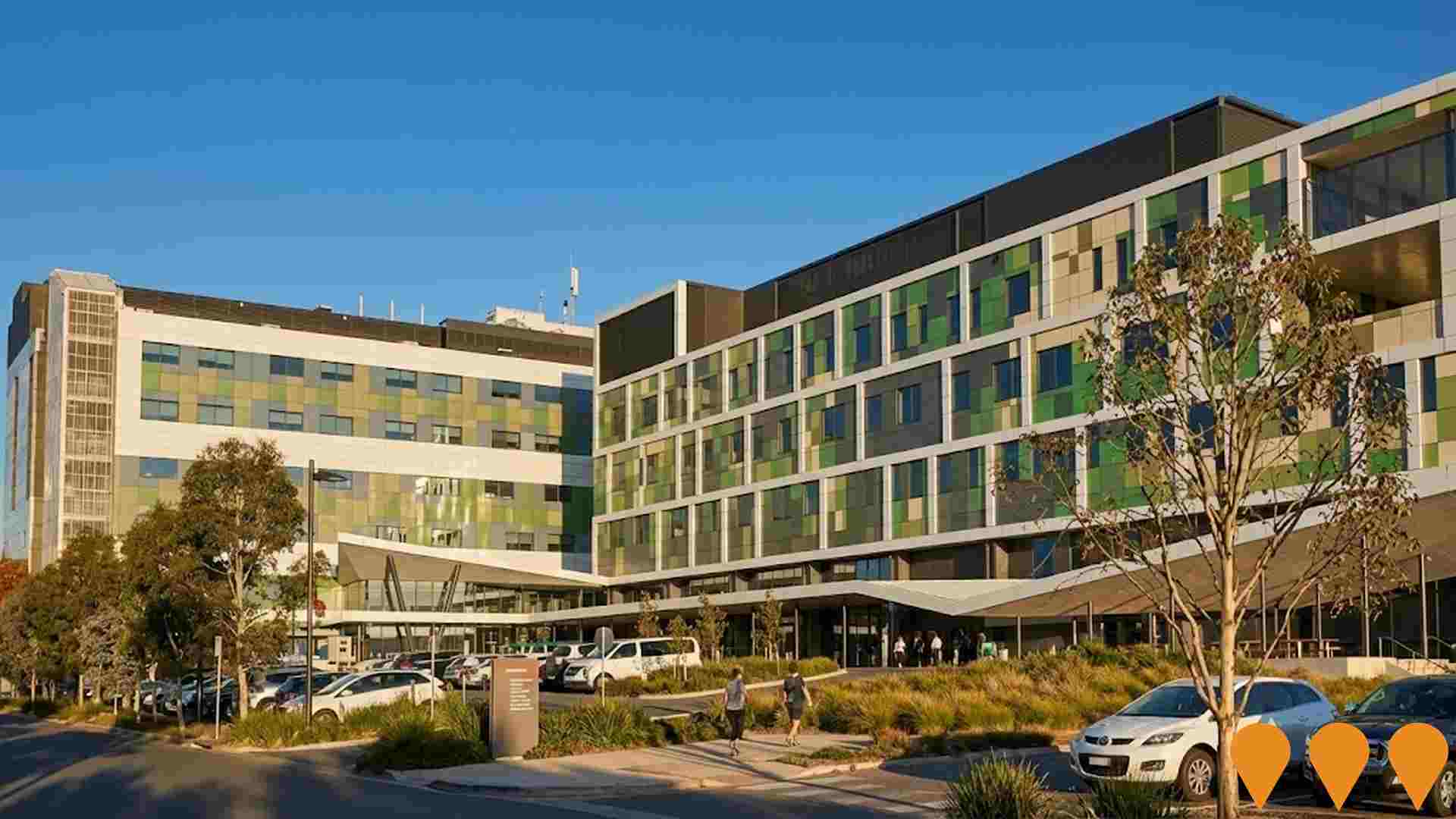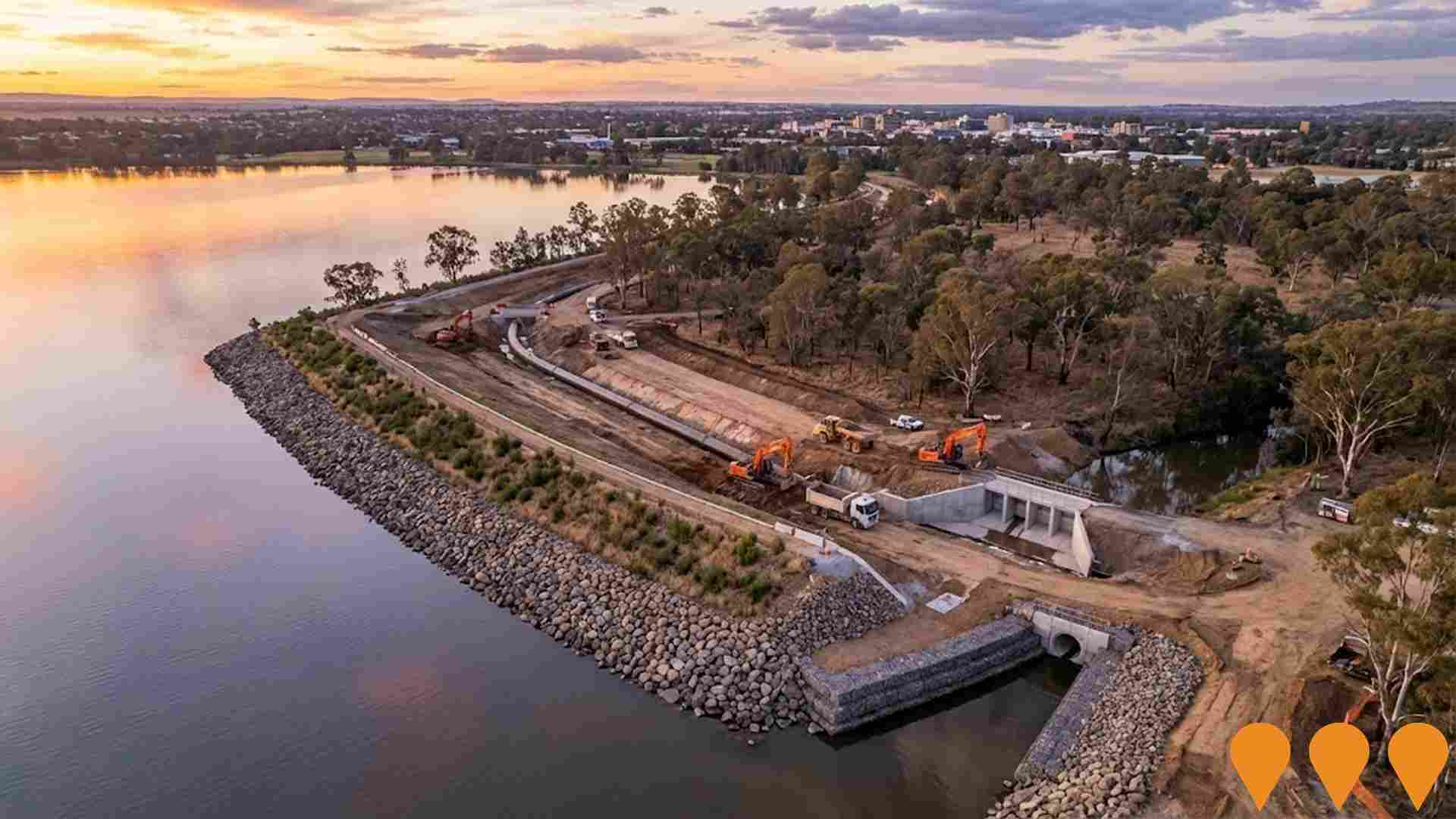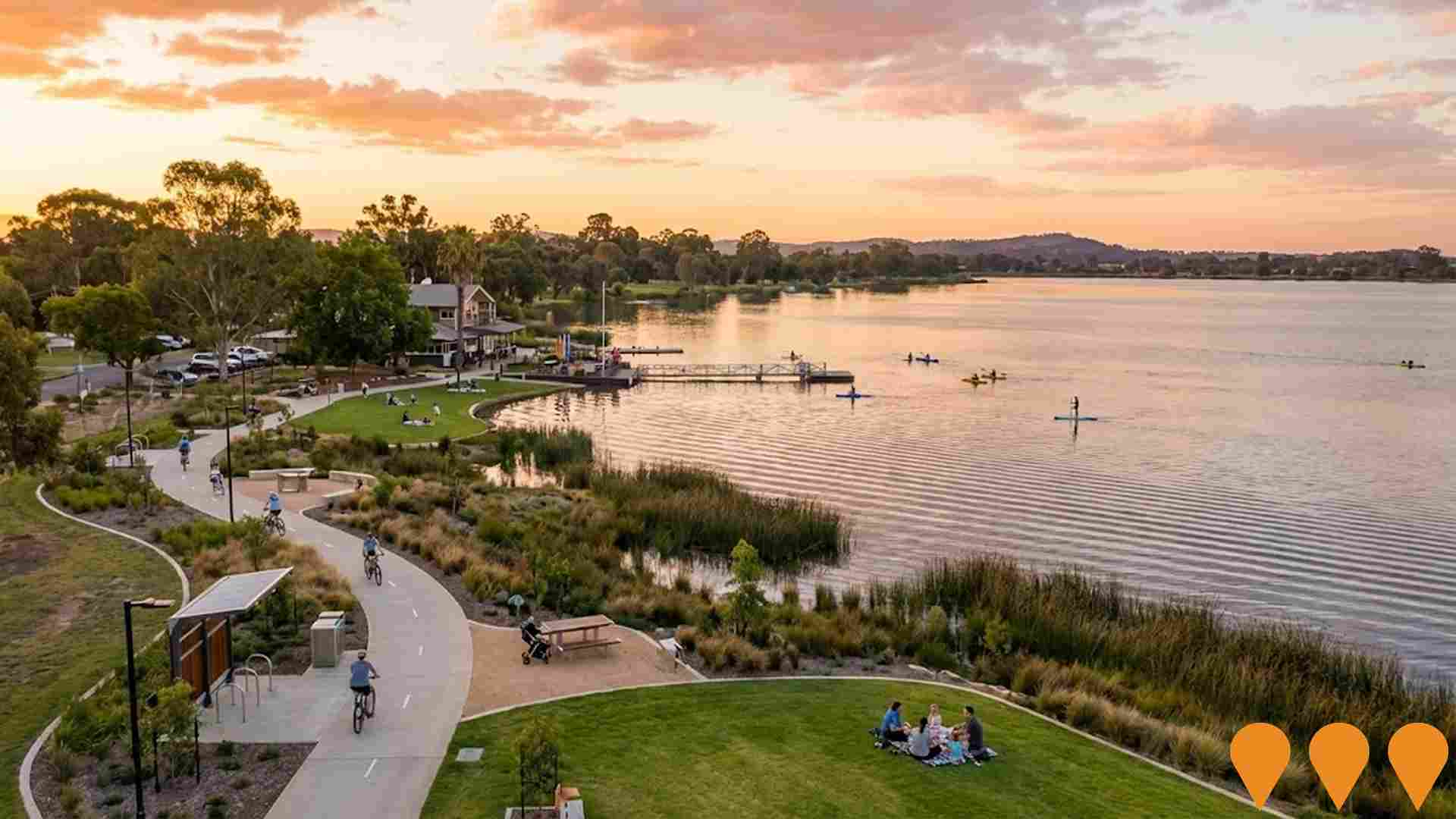Chart Color Schemes
est. as @ -- *
ABS ERP | -- people | --
2021 Census | -- people
Sales Activity
Curious about local property values? Filter the chart to assess the volume and appreciation (including resales) trends and regional comparisons, or scroll to the map below view this information at an individual property level.
Find a Recent Sale
Sales Detail
Population
Wagga Wagga - East is positioned among the lower quartile of areas assessed nationally for population growth based on AreaSearch's assessment of recent, and medium term trends
Wagga Wagga - East's population is around 17,198 as of Aug 2025. This reflects an increase from the 16,921 people reported in the 2021 Census. The growth of 277 people (1.6%) is inferred from ABS data showing an estimated resident population of 16,938 in June 2024 and an additional 200 validated new addresses since the Census date. This results in a density ratio of 318 persons per square kilometer. Wagga Wagga - East's growth rate is within 1.7 percentage points of the SA3 area (3.3%), indicating competitive growth fundamentals. Natural growth contributed approximately 54.8% of overall population gains during recent periods.
AreaSearch uses ABS/Geoscience Australia projections for each SA2 area, released in 2024 with a base year of 2022. For areas not covered by this data, NSW State Government's SA2 level projections are used, released in 2022 with a base year of 2021. Growth rates by age group from these aggregations are applied to all areas for years 2032 to 2041. By 2041, the area's population is projected to decline by 1,123 persons. However, specific age cohorts like the 85 and over group are expected to grow, with a projected increase of 476 people.
Frequently Asked Questions - Population
Development
Residential development activity is lower than average in Wagga Wagga - East according to AreaSearch's national comparison of local real estate markets
Wagga Wagga - East averaged approximately 53 new dwelling approvals annually. From FY21 to FY25265 homes were approved, with an additional 24 approved in FY26 so far. Despite population decline, development activity has been adequate relative to other areas.
The average construction cost value of new dwellings is $564,000, reflecting quality-focused development. This financial year, there have been $17.5 million in commercial approvals, indicating steady commercial investment activity. Compared to the Rest of NSW and nationally, Wagga Wagga - East records around 63% of building activity per person, placing it at the 55th percentile nationally. This suggests the area's established nature and potential planning limitations.
New building activity comprises 88.0% standalone homes and 12.0% medium and high-density housing, maintaining the area's traditional low density character appealing to those seeking space. The location has approximately 297 people per dwelling approval, indicating a low density market. With population expected to remain stable or decline, Wagga Wagga - East may see reduced pressure on housing, potentially creating opportunities for buyers.
Frequently Asked Questions - Development
Infrastructure
Wagga Wagga - East has emerging levels of nearby infrastructure activity, ranking in the 28thth percentile nationally
The performance of an area can significantly be influenced by changes in local infrastructure, major projects, and planning initiatives. AreaSearch has identified a total of 39 projects that are expected to impact the area. Notable projects include the Riverina Intermodal Freight and Logistics (RiFL) Hub, Lake Albert Pipeline and Precinct Renewal, Lake Albert Manors, and Bourkelands Neighbourhood Shopping Centre. The following list details those projects likely to be most relevant.
Professional plan users can use the search below to filter and access additional projects.
INFRASTRUCTURE SEARCH
 Denotes AI-based impression for illustrative purposes only, not to be taken as definitive under any circumstances. Please follow links and conduct other investigations from the project's source for actual imagery. Developers and project owners wishing us to use original imagery please Contact Us and we will do so.
Denotes AI-based impression for illustrative purposes only, not to be taken as definitive under any circumstances. Please follow links and conduct other investigations from the project's source for actual imagery. Developers and project owners wishing us to use original imagery please Contact Us and we will do so.
Frequently Asked Questions - Infrastructure
Wagga Wagga Health Service Redevelopment Stage 3
Stage 3 of the Wagga Wagga Health Service Redevelopment delivered a new multi-storey ambulatory care (Health Services Hub) building consolidating sub-acute, ambulatory, community and primary health services. Key inclusions: 28 aged care beds, 24 rehabilitation beds, a 24-bed mental health inpatient unit, a 20-chair renal dialysis unit, education and training facilities, and a basement car park. The overall redevelopment reached completion in 2021, with Stage 3 operationally commissioned in late 2020.

Rowan Village
A $2.5 billion master-planned community by DevCore Property Group featuring 2,100 homes across 220 hectares in Wagga's Southern Growth Area. Includes diverse housing types from first home buyer to seniors living, village centre with supermarket, medical facilities, childcare, schools, parks, walking trails, and sustainable infrastructure. Development over 20 stages commencing 2027, with Stage One currently under assessment.

Bourkelands Neighbourhood Shopping Centre
Neighbourhood scale shopping centre approved under DA07/1097 for a FoodWorks anchored supermarket, five specialty shops and about 73 parking spaces on the corner of Bourkelands Drive and Bourke Street in Bourkelands, Wagga Wagga. The Wagga Wagga Interim Joint Planning Panel approved the $5.26 million development in June 2011, but subsequent reporting indicates the project has stalled indefinitely and the centre has not been constructed, with the site remaining undeveloped and zoned for a future shopping centre.

Southern Growth Area
An 844.8ha urban growth precinct south of Wagga Wagga, divided into four zones to accommodate long-term housing needs. Zone 1 (341.6ha, comprising Rowan Village and Sunnyside) is currently under active rezoning (Planning Proposal LEP24/0003, on public exhibition until December 2025) for approximately 2,900 dwellings plus supporting infrastructure, commercial areas, and open space. Zones 2-4 are in early strategic planning. The precinct addresses regional housing shortages and is proponent-led in Zone 1 by private developers in partnership with Wagga Wagga City Council.

Riverina Intermodal Freight and Logistics (RiFL) Hub
Multi-million dollar intermodal freight and logistics hub at Bomen in Wagga Wagga (45km from Griffith) featuring a 4.6 kilometre rail master siding connecting to the main southern railway and intermodal terminal. Part of the Wagga Wagga Special Activation Precinct with over $137 million NSW Government investment. Major freight terminal development connecting road and rail networks to support agricultural exports and regional freight distribution with container handling facilities and logistics warehouses.

Wagga Wagga Special Activation Precinct
NSW Government's $212 million investment in the 4,500 hectare Wagga Wagga Special Activation Precinct focusing on high value agriculture, manufacturing, freight and logistics, renewable energy and recycling industries. Features master planning, enabling infrastructure, accelerated planning pathways and business concierge services. Creation of a dedicated agribusiness and food processing hub including upgraded rail infrastructure, new road network, industrial land development, water and sewer infrastructure. The precinct will create up to 6,000 new jobs across a range of industries. Major $137 million Special Activation Precinct covering 4,500 hectares including industrial land, freight rail links, digital connectivity and streamlined planning. Expected to create 6,000 jobs and includes specialized manufacturing and logistics hub with advanced manufacturing facilities, renewable energy integration, research and development spaces, and supporting commercial areas. The precinct includes the Riverina Intermodal Freight and Logistics Hub (RiFL) and focuses on advanced manufacturing, agribusiness, and freight logistics with fast-tracked planning approvals.

Lake Albert Pipeline and Precinct Renewal
Major $9 million project including pipeline from Murrumbidgee River to Lake Albert, 2.78km embankment stabilisation, stormwater outlet rehabilitation, foreshore remediation works, and weir upgrade works to improve water quality and maintain consistent water levels.

Lake Albert Plan of Management 2025-2035
A 10-year plan adopted by Wagga Wagga City Council to guide the management, use and future development of the Lake Albert precinct (including Crown Land and Council land). The plan sets a strategic framework for amenity improvements, recreation, Aboriginal cultural values, biodiversity and water quality, with implementation via future investigations, business cases and funding programs.

Employment
AreaSearch assessment positions Wagga Wagga - East ahead of most Australian regions for employment performance
Wagga Wagga - East has a skilled workforce with strong representation in essential services sectors. Its unemployment rate is 3.4%, lower than the national average of 5.1% as of June 2021.
Employment growth over the past year was estimated at 7.6%. As of June 2025, 8,531 residents are employed with an unemployment rate of 3.1%, below Rest of NSW's rate of 3.7%. Workforce participation is high at 63.7% compared to Rest of NSW's 56.4%. Key employment sectors include health care & social assistance, education & training, and construction.
Education & training has a particularly strong presence with an employment share 1.3 times the regional level. Agriculture, forestry & fishing, however, has limited presence at 2.4% compared to the regional average of 5.3%. AreaSearch analysis shows employment levels increased by 7.6% and labour force grew by 9.0% during the year to June 2025, leading to an unemployment rise of 1.2 percentage points. Jobs and Skills Australia's national employment forecasts from May 2025 project overall growth of 6.6% over five years and 13.7% over ten years. Applying these projections to Wagga Wagga - East's employment mix suggests local growth could approximate these rates, though this is a simplified extrapolation for illustrative purposes only.
Frequently Asked Questions - Employment
Income
Income levels align closely with national averages, indicating typical economic conditions for Australian communities according to AreaSearch analysis
Wagga Wagga - East's median income among taxpayers was $54,167 and average income stood at $66,030 in financial year 2022. These figures compare to Rest of NSW's median income of $49,459 and average income of $62,998 respectively. As of September 2025, current estimates based on Wage Price Index growth since financial year 2022 are approximately $60,997 (median) and $74,356 (average). Census data indicates that household, family and personal incomes in Wagga Wagga - East cluster around the 53rd percentile nationally. Income brackets show that 33.2% of the population (5,709 individuals) fall within the $1,500 - 2,999 income range, similar to the surrounding region where 29.9% occupy this range. After housing costs, residents retain 87.7% of their income, reflecting strong purchasing power and placing the area's SEIFA income ranking in the 5th decile.
Frequently Asked Questions - Income
Housing
Wagga Wagga - East is characterized by a predominantly suburban housing profile, with ownership patterns similar to the broader region
Dwelling structure in Wagga Wagga - East, as per the latest Census, consists of 88.0% houses and 12.0% other dwellings (semi-detached, apartments, 'other' dwellings). This compares to Non-Metro NSW's 88.4% houses and 11.7% other dwellings. Home ownership in Wagga Wagga - East aligns with Non-Metro NSW at 36.3%. The remaining dwellings are either mortgaged (36.9%) or rented (26.8%). The median monthly mortgage repayment is $1,517, higher than Non-Metro NSW's average of $1,430. Median weekly rent in the area is $300, compared to Non-Metro NSW's $280. Nationally, Wagga Wagga - East's median monthly mortgage repayment is lower at $1,517 than the Australian average of $1,863. Weekly rents are substantially below the national figure of $375.
Frequently Asked Questions - Housing
Household Composition
Wagga Wagga - East has a typical household mix, with a higher-than-average median household size
Family households constitute 72.1% of all households, including 30.7% couples with children, 28.4% couples without children, and 12.0% single parent families. Non-family households account for the remaining 27.9%, with lone person households at 25.2% and group households comprising 2.8%. The median household size is 2.6 people, larger than the Rest of NSW average of 2.5.
Frequently Asked Questions - Households
Local Schools & Education
Educational attainment in Wagga Wagga - East aligns closely with national averages, showing typical qualification patterns and performance metrics
Educational qualifications in Wagga Wagga - East trail regional benchmarks. As of the latest data, 22.9% of residents aged 15+ hold university degrees, compared to the NSW average of 32.2%. This gap suggests potential for educational development and skills enhancement. Bachelor degrees are the most common at 15.6%, followed by postgraduate qualifications (4.5%) and graduate diplomas (2.8%).
Vocational credentials are also prominent, with 38.7% of residents aged 15+ holding such qualifications - advanced diplomas account for 10.3%, while certificates make up 28.4%. Educational participation is high, with 30.3% of residents currently enrolled in formal education. This includes 11.3% in primary education, 8.9% in secondary education, and 3.6% pursuing tertiary education. There are approximately 10 schools operating within Wagga Wagga - East, educating around 4,300 students. The area has balanced educational opportunities, with an ICSEA score of 1016, typical for Australian schools. The school mix includes 7 primary, 2 secondary, and 1 K-12 school. Wagga Wagga - East functions as an education hub, offering 25.0 school places per 100 residents, significantly above the regional average of 15.3, attracting students from surrounding communities. Note: for schools with 'n/a' enrolments, please refer to the parent campus.
Frequently Asked Questions - Education
Schools Detail
Nearby Services & Amenities
Transport
Transport servicing is low compared to other areas nationally based on assessment of service frequency, route connectivity and accessibility
Wagga Wagga - East has 93 active public transport stops operating within its boundaries. These stops are a mix of train and bus services, totaling 92 individual routes that collectively provide 877 weekly passenger trips. The accessibility of these services is rated as good, with residents typically located 273 meters from the nearest transport stop.
On average, there are 125 trips per day across all routes, which equates to approximately 9 weekly trips per individual stop.
Frequently Asked Questions - Transport
Transport Stops Detail
Health
Health performance in Wagga Wagga - East is lower than average with common health conditions somewhat prevalent across both younger and older age cohorts
Wagga Wagga - East has significant health challenges with common conditions prevalent across both younger and older age groups.
The private health cover rate is approximately 52%, covering around 9,011 people, which is higher than the average SA2 area. Asthma and mental health issues are the most common medical conditions, affecting 10.0% and 8.9% of residents respectively. About 64.8% of residents report no medical ailments, compared to 64.5% in Rest of NSW. The area has a higher proportion of seniors aged 65 and over, at 20.7% (3,565 people), compared to the 19.6% in Rest of NSW. Health outcomes among seniors present challenges broadly inline with the general population's health profile.
Frequently Asked Questions - Health
Cultural Diversity
Wagga Wagga - East is considerably less culturally diverse than average when assessed alongside AreaSearch's national rankings for language and cultural background related metrics
Wagga Wagga-East had low cultural diversity, with 91.1% citizens, 89.6% born in Australia, and 92.7% speaking English only at home. Christianity was the main religion at 64.0%, close to Rest of NSW's 64.3%. Top ancestry groups were Australian (30.5%), English (30.0%), Irish (10.1%).
Notably, Australian Aboriginal were overrepresented at 4.0% compared to regional 4.5%, Scottish at 8.4% vs 8.0%, and German at 3.8% vs 3.9%.
Frequently Asked Questions - Diversity
Age
Wagga Wagga - East's population is slightly younger than the national pattern
Wagga Wagga - East has a median age of 38, which is lower than the Rest of NSW figure of 43 but equivalent to the national norm of 38. The 25-34 age group makes up 13.2% of the population in Wagga Wagga - East, higher than the Rest of NSW figure. Conversely, the 55-64 cohort comprises 10.5%, lower than the Rest of NSW figure. According to the 2021 Census, the 25 to 34 age group has increased from 11.9% to 13.2% of the population in Wagga Wagga - East. Meanwhile, the 5 to 14 cohort has decreased from 14.8% to 13.3%, and the 55 to 64 group has dropped from 11.6% to 10.5%. Demographic modeling suggests that by 2041, Wagga Wagga - East's age profile will change significantly. The 85+ group is projected to grow by 92%, from 471 to 907 people. This growth is predominantly driven by the aging population dynamic, with those aged 65 and above accounting for 94% of the projected growth. However, the 65-74 and 0-4 age cohorts are expected to experience population declines.



